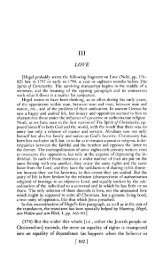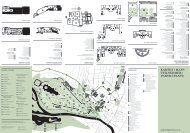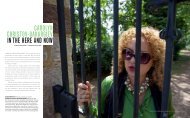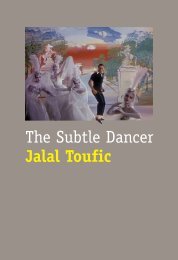A Conversation between Anna Maria Maiolino and Helena Tatay
A Conversation between Anna Maria Maiolino and Helena Tatay
A Conversation between Anna Maria Maiolino and Helena Tatay
- No tags were found...
You also want an ePaper? Increase the reach of your titles
YUMPU automatically turns print PDFs into web optimized ePapers that Google loves.
2. O Cordel is the popular literature typical of the northeast of Brazil. They are narrative poemsillustrated with woodcuts, printed in the form of small booklets <strong>and</strong> hung from a string to be sold. Thethemes may be traditional or based on current events. They can be humorous, too.3. The Anthropophagous Manifesto, written by Oswald de Andrade (1890–1954), was published inMay 1928 in the first issue of the recently founded magazine Revista de Antropofagia, a vehicle forthe diffusion of Brazilian anthropophagous culture. With its metaphorical language, full of poetic <strong>and</strong>humorous aphorisms, the Manifesto became the theoretical basis for this movement, which questionedBrazil’s cultural dependence. The apex of early Modernism, the anthropophagous period wasofficially inaugurated during the Semana de Arte Moderno (Week of Modern Art), 1922. Ithighlighted the violent contradiction <strong>between</strong> two cultures – primitive culture (Amerindian <strong>and</strong>African) <strong>and</strong> Latin culture (of European descent) – which form the basis of Brazilian culture, throughthe transformation of the savage element into an aggressive instrument. It is not a question ofharmonious, spontaneous assimilation <strong>between</strong> the two. On the contrary, primitivism now appears asa sign of critically devouring the other, the modern <strong>and</strong> civilised.4. The text Declaração de Principios Básicos da Nova Vanguarda (Declaration of the BasicPrinciples of the New Avant-garde) accompanied the exhibition New Brazilian Objectivity. It wassigned by Hélio Oiticica, Antonio Dias, Carlos Vergara, Rubens Gerchman, Lygia Pape, GlaucoRodrigues, Carlos Zilio, Mário Pedrosa, Maurício Nogueira Lima, among others.5. The Semana de Arte Moderno was part of the celebrations of the centenary of Brazilianindependence in 1922. It was presented as the first collective public manifestation in the history ofBrazilian culture, in favour of a new modern spirit <strong>and</strong> against the conservative art <strong>and</strong> culture thathad been prevalent in the country since the nineteenth century. From 13 to 18 February 1922, afestival was held at the Teatro Municipal, São Paulo, with an exhibition of over one hundred works<strong>and</strong> three literary-musical evenings. Without a defined aesthetic programme, the Week can be seen, inthe context of the history of Brazilian art, more as a rejection of the current conservatism in literary,musical <strong>and</strong> visual production, than as a constructive event with specific proposals for the creation ofa new language. What united all the participants, according to the two principal ideologists Mário <strong>and</strong>Oswald de Andrade, was the negation of all ‘devotion to the past’ <strong>and</strong> the rejection of imported art<strong>and</strong> literature.5. The Semana de Arte Moderno was part of the celebrations of the centenary of Brazilianindependence in 1922. It was presented as the first collective public manifestation in the history ofBrazilian culture, in favour of a new modern spirit <strong>and</strong> against the conservative art <strong>and</strong> culture thathad been prevalent in the country since the nineteenth century. From 13 to 18 February 1922, afestival was held at the Teatro Municipal, São Paulo, with an exhibition of over one hundred works<strong>and</strong> three literary-musical evenings. Without a defined aesthetic programme, the Week can be seen, inthe context of the history of Brazilian art, more as a rejection of the current conservatism in literary,musical <strong>and</strong> visual production, than as a constructive event with specific proposals for the creation ofa new language. What united all the participants, according to the two principal ideologists Mário <strong>and</strong>Oswald de Andrade, was the negation of all ‘devotion to the past’ <strong>and</strong> the rejection of imported art<strong>and</strong> literature.5. The Semana de Arte Moderno was part of the celebrations of the centenary of Brazilianindependence in 1922. It was presented as the first collective public manifestation in the history ofBrazilian culture, in favour of a new modern spirit <strong>and</strong> against the conservative art <strong>and</strong> culture thathad been prevalent in the country since the nineteenth century. From 13 to 18 February 1922, afestival was held at the Teatro Municipal, São Paulo, with an exhibition of over one hundred works<strong>and</strong> three literary-musical evenings. Without a defined aesthetic programme, the Week can be seen, inthe context of the history of Brazilian art, more as a rejection of the current conservatism in literary,musical <strong>and</strong> visual production, than as a constructive event with specific proposals for the creation ofa new language. What united all the participants, according to the two principal ideologists Mário <strong>and</strong>








